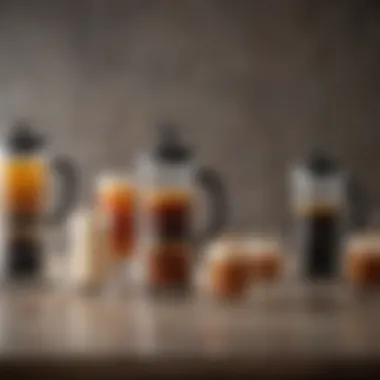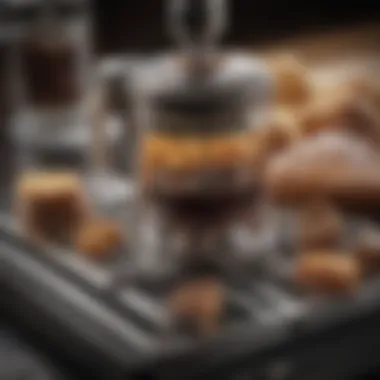Exploring Frieling French Press Sizes: A Guide


Intro
In the world of coffee brewing, the French press remains an esteemed device among enthusiasts and casual drinkers alike. Specifically, the Frieling brand stands out for its high-quality materials and innovative designs. Understanding the different sizes available can significantly enhance the brewing experience. Each size of Frieling French press offers distinctive features and capacities that cater to various lifestyles and preferences. This guide will assist you in navigating these choices, ensuring you find the right fit for your brewing needs.
Frieling French Press Sizes
The Frieling French press comes in several sizes—each designed to serve a particular number of cups while maintaining the quality of coffee produced. The common sizes range from smaller models that typically brew one or two cups to larger options capable of making a robust pot of coffee for gatherings.
Importance of Size Choice
Choosing the right size is crucial. A press that is too small may not meet your caffeine demands, while one that is too large could lead to wasted coffee. Each size offers unique advantages:
- Small (12 oz): Ideal for intimate settings, perfect for one or two people.
- Medium (24 oz): Suited for small families or couples who enjoy multiple cups throughout the morning.
- Large (36 oz): Great for larger gatherings or for those who drink coffee throughout the day.
"Understanding your brewing needs can lead to a more satisfying coffee experience."
Unique Features of Frieling French Presses
In addition to size, several features enhance the brewing process. The Frieling French press uses double-wall insulation to maintain optimal temperature, and the stainless steel construction ensures durability. Each size retains these key features, making every model capable of providing a superior brew.
Brewing Mechanics
The mechanics of brewing coffee in a French press involve steeping the coffee grounds in hot water and then pressing the grounds down to separate them from the liquid. The Frieling design simplifies these mechanics with a filter that effectively extracts the rich flavors while minimizing sediment in your cup.
Practical Usage Tips
To maximize your experience with the Frieling French press, consider these tips:
- Use coarsely ground coffee for the best flavor extraction.
- Maintain a coffee-to-water ratio of approximately 1:15.
- Allow the coffee to steep for about four minutes before pressing.
By following these guidelines, users can ensure they are brewing a high-quality cup of coffee that meets personal taste preferences.
Final Thoughts
Selecting the right size Frieling French press can be a transformative decision for coffee lovers. Not only does it affect the quality of the coffee, but it also impacts the experience of brewing. By being informed about the different sizes and their unique features, you can enhance your coffee journey.
Foreword to Frieling French Press
The charisma of the French press lies not only in its brewing method but also in its mechanics and design. This section delves into the intricacies of the Frieling French Press, a well-regarded option among coffee enthusiasts. Understanding this brewing device is essential, especially since it affects the quality of your coffee. An informed choice can elevate your daily routine and enhance your enjoyment of coffee.
Understanding the French Press Mechanism
The French press operates on a straightforward yet efficient principle. It uses a plunger and a fine mesh filter to separate coffee grounds from brewed coffee. The process involves steeping coarsely ground coffee in hot water, allowing extact flavors and aromas to infuse the liquid. After a few minutes, the plunger is pushed down, trapping the ground coffee at the bottom of the carafe. This method allows for a full-bodied cup, capturing the essential oils of the coffee beans.
Some people appreciate this brewing method due to its simplicity and the minimal equipment required. Moreover, it requires no electricity, making it convenient for various settings, from home to camping. Understanding how this mechanism works helps users to exploit its benefits, leading to better brewing results.


Origin and Evolution of the French Press
The French press, as we know it today, has an interesting history. It can be traced back to the 19th century in France when a prototype was created by using a metal mesh to filter coffee. Early designs were made from various materials, including wood and metal. Over time, the design underwent changes to improve functionality and ease of use.
In the contemporary stage, brands like Frieling offer advanced versions of the French press that emphasize durability and design. Frieling focuses on using high-quality materials, such as stainless steel, which enhances the overall brewing experience and extends the lifespan of the product. Understanding the evolution of the French press highlights how innovation has shaped coffee brewing, bringing us to the diverse offerings available today.
Features of Frieling French Presses
The features of Frieling French presses play a significant role in defining their usability and appeal. The right features enhance the brewing process, making coffee preparation more efficient and enjoyable. Different materials, design elements, and overall aesthetics contribute to the experience coffee lovers seek in a French press.
Materials Used in Construction
Stainless Steel
Stainless Steel is popular for French presses due to its durability and heat retention properties. It is resistant to rust and can withstand the rigors of daily use. Many coffee enthusiasts appreciate how stainless steel keeps coffee hot longer than glass variants. Moreover, it offers a sleek, modern look that fits well in both casual and upscale settings.
However, some users might miss the visual aspect of brewing as they cannot see the coffee during the steeping process. Yet, the insulating capabilities and robust nature of stainless steel make it an excellent choice for those who prioritize performance and longevity.
Glass Variants
Glass variants are another common choice for French presses. They provide a clear view of the brewing process, allowing users to monitor the color and consistency of the coffee as it steeps. The aesthetics of glass can also enhance the overall presentation when serving coffee.
However, glass can be prone to chipping or breaking, which is a consideration for users who may handle their press more vigorously. Glass offers a visual appeal but may require more careful handling compared to its stainless steel counterpart.
Borosilicate Glass
Borosilicate glass takes the benefits of standard glass construction and elevates them. This material is designed to withstand thermal shock, making it less likely to break when exposed to hot water. It retains the visual advantages of glass while improving durability.
The clarity of borosilicate glass allows users to witness the coffee brewing in real-time, exhibiting the infusion of flavors and aromas. Users who prefer to see their brew cycle may find borosilicate a compelling option. On the downside, while stronger than regular glass, it can still break under extreme stress.
Design and Aesthetic Appeal
Design and aesthetic appeal of Frieling French presses significantly impact user experience. These items blend function and beauty, often becoming a statement piece in kitchen decor. A well-designed French press usually features comfortable grips, easy-pour spouts, and a clean, stylish look that matches various interiors.
Customization possibilities also exist. Some users may prefer polished stainless steel for a contemporary vibe, while others may lean towards the rustic charm of a glass press. The choice of design should reflect personal style while remaining practical for everyday use.
Overview of Available Sizes
Understanding the available sizes of Frieling French presses is crucial for any coffee enthusiast. Each size caters to different brewing needs, ultimately influencing the coffee experience. Selecting the right size ensures that your brewing process meets your personal consumption habits and social activities. This section focuses on the distinctive characteristics and implications of the four available sizes: small, medium, large, and extra-large. By the end of this exploration, readers will grasp how these sizes align with their specific requirements.
Small Size: Ideal for Single Servings
The small-sized Frieling French press is designed primarily for individuals or those who relish a solitary yet rich coffee experience. Typically, this size holds about 12 ounces of coffee, which is suitable for one or two servings.
This option is especially beneficial for those who prefer freshly brewed coffee without excessive quantities. Its compact design allows for easy storage and simplicity in use.
For someone who enjoys varying their coffee choices daily, a small size eliminates waste and keeps flavors vibrant. Notably, it can serve as a travel companion, fitting well into a backpack or luggage.


Medium Size: Suitable for Small Groups
The medium-sized French press accommodates around 20 to 30 ounces of liquid, making it an ideal choice for small gatherings or office settings. Families may find this size practical for breakfast or shared afternoon coffee breaks.
Choosing the medium size fosters a balance between quantity and ease of use. It provides enough servings for about two to four people, which suffices for small groups. Moreover, it does not take up much counter space, appealing to those with limited kitchen real estate.
Large Size: Perfect for Entertaining
Moving up in size, the large Frieling French press typically holds about 34 ounces, catering to more significant occasions. This variant excels in situations where multiple guests are expected, from dinner parties to celebratory events.
By choosing the large size, hosts can brew enough coffee to keep attendees satisfied without multiple rounds of brewing. This ensures the focus remains on socializing rather than monitoring coffee pots. The larger capacity also supports the enjoyment of different coffee blends, appealing to diverse tastes.
Extra-Large Size: Best for Gathering
For events where coffee consumption is at its peak, the extra-large French press is indispensable. With a capacity often exceeding 50 ounces, it is designed for gatherings, catering events, or busy mornings with family and friends.
Not only does it serve an abundant quantity, but it also maintains the classic French press styling that complements any occasion. The extra-large French press minimizes the need for frequent refills, allowing guests to pour their coffee at their own pace. It reflects an understanding of community, as it can facilitate conversations over multiple cups of coffee.
In summary, understanding the available sizes of Frieling French presses allows users to tailor their coffee experience to their needs, preferences, and social context. Each size possesses unique strengths that can enhance the coffee brewing and drinking experience.
Comparative Analysis of Sizes
Understanding the comparative analysis of Frieling French press sizes is essential for anyone looking to optimize their brewing experience. Each size variant serves different purposes and caters to a variety of preferences. This analysis helps users weigh the benefits and limitations of each size, aligning the choice with their specific needs. The size of a French press can significantly influence not just the quantity of coffee produced but also the overall brewing process. Evaluating these aspects can lead to better satisfaction and enjoyment while brewing coffee.
Coffee Yield and Portion Control
Different sizes of Frieling French presses yield varying amounts of coffee. The small size, for instance, is tailored for single servings, making it an excellent option for individual use. Depending on the model, it can typically brew around 8 ounces of coffee, just enough for a personal cup. The medium size, on the other hand, produces about 17 ounces, which is suitable for small groups or a cozy morning with friends.
The large and extra-large variants are designed for larger gatherings. The large size can brew up to 33 ounces, perfect for entertaining a few guests, while the extra-large size can yield up to 51 ounces. This is particularly beneficial during gatherings where many cups of coffee are required. How one dislikes flavor dilution must also be considered. Small presses allow for greater portion control, often leading to more concentrated brews. In contrast, larger presses might mean adjusting the coffee grounds to maintain flavor intensity while maximizing yield.
Space Considerations for Storage
When selecting a Frieling French press size, storage space should also be considered. The compact design of the small French press makes it incredibly easy to store. This is useful for those with limited kitchen space or individuals who may frequently relocate their brewing equipment. On the flip side, larger models require more space, not only for storage but also for serving and preparation.
One must also consider the storage of necessary additional accessories like coffee beans and filters. If having a dedicated coffee corner is appealing, one could invest in larger presses, where larger quantities of coffee can be brewed at once. Hence, the decision may hinge on the available space and how it aligns with one's brewing preferences.
Brewing Time Variations Across Sizes
Brewing time can also vary with different sizes of French presses. Generally, larger presses will require a similar amount of brewing time as smaller ones. However, the overall process may feel different due to the volume of coffee being prepared. For instance, a small press may reach optimal brewing conditions in about four minutes, while a large press will take the same time, yet the user might perceive it as longer because of the increased volume.
Timing can be crucial. Over-extraction can lead to bitterness in your brew, independent of the size used. Therefore, it’s crucial to keep an eye on steeping times, particularly when using larger variants. This ensures that the delicious flavors are balanced and not overpowered by bitterness or acidity. The strategy for brewing should also vary; small presses may offer more quick, focused brewing sessions, while larger presses may invite prolonged enjoyment during gatherings or events.
The ability to control portion size, storage convenience, and brewing time significantly impacts your coffee experience. Understanding these elements helps in making an informed choice regarding the size of a French press.
Choosing the Right Size for Your Needs
The significance of selecting the right size of a Frieling French press cannot be understated. Many factors come into play depending on individual preferences, consumption habits, and social contexts. Picking the ideal size allows for an enhanced brewing experience and can significantly alter the enjoyment derived from your coffee. Understanding various dimensions ensures that users do not face disappointments in flavor or quantity. The right size can also save space in the kitchen and prevent unnecessary waste. Thus, it is important to evaluate your needs carefully before making a decision.


Evaluating Your Coffee Consumption
Start by taking stock of your daily coffee consumption. How often do you brew coffee? Are you a solo drinker or do you share your coffee with others? If you consume a single cup daily, a small Frieling French press may be suitable. However, if you are someone who enjoys multiple cups or brews for guests, a larger model would be advantageous.
For consistent users, understanding the volume of coffee consumed per brewing session can help assess which size aligns best with your habits. Keep in mind the brewing capacity for each size. For instance, a small press typically holds around 8 ounces while larger ones can accommodate over 40 ounces. Having an accurate measure of how much coffee you require ensures optimal satisfaction.
Understanding Your Brewing Preferences
Consider your desired coffee strength and flavor profile. The size of your French press influences not just the quantity produced but the concentration of the coffee. A smaller press allows for a more potent brewing experience, ideal for those who prefer intense flavors. Conversely, if you plan to dilute or prepare weaker coffee, using a larger press may be more fitting.
Moreover, explore your technique preferences. Some users enjoy experimenting with brewing times and grind sizes. The French press mechanism requires a balance of coffee grounds to water ratio, which can change based on your chosen size. Experimentation could demand a certain size as a necessity for achieving the desired taste.
Considering Your Social Context
Social settings play a crucial role in determining the appropriate size for your needs. If you frequently host guests or enjoy family gatherings, a larger size French press enables you to brew coffee for multiple people without prolonging the serving time.
On the other hand, if your coffee moments are typically solitary or intimate, selecting a smaller size alleviates clutter on your countertop. In essence, your lifestyle dynamics will significantly dictate your choice; ponder over occasions where brewing coffee is an event rather than a routine—the semi-formal gatherings might lean towards the larger sizes, enhancing communal experiences.
As a result, your social context can help guide your decision when choosing the right size. Remember that each size comes with its pros and cons, making it essential to factor in these social elements as part of your consideration process.
Practical Tips for Using Frieling French Presses
Understanding how to use a Frieling French press effectively can greatly enhance your coffee experience. It's important not only to know the brewing methods but also to focus on maintenance to keep your press in good condition. This section outlines essential tips that will help both new and experienced users optimize their brewing process and prolong the life of their equipment.
How to Brew Coffee in a French Press
Brewing coffee in a Frieling French press is a straightforward process once you grasp the fundamental steps:
- Select Quality Coffee Beans: Start with fresh, high-quality coffee beans. This will significantly influence the flavor of your brew. Consider using a medium grind for the best extraction results.
- Measure Coffee and Water: A common ratio is two tablespoons of coffee per six ounces of water. Adjust this ratio depending on your strength preference.
- Heat the Water: Bring the water to a temperature of about 200°F (93°C). This is just below boiling and ideal for extracting flavors without scalding the coffee.
- Combine Coffee and Water: Add the ground coffee into the press and pour the heated water over it.
- Stir Gently: Use a wooden or plastic spoon to stir the mixture gently. This helps ensure all coffee grounds are saturated.
- Put the Lid On: Place the lid on the French press, but do not press down yet. Let the coffee steep for about four minutes.
- Press Down the Plunger: After steeping, slowly press down the plunger. This separates the grounds from the brewed coffee.
- Serve Immediately: Pour the coffee into your cup. Avoid leaving it in the press for too long to prevent bitterness.
Using the correct grind and steeping time are crucial for achieving the best flavor.
By following these steps, you can enjoy a well-brewed cup of coffee with the rich taste that a French press offers.
Cleaning and Maintenance for Longevity
Regular cleaning and maintenance are vital to prolonging the life and performance of your Frieling French press. Here are some important considerations:
- Disassemble After Use: After serving, disassemble the French press. Take out the plunger and filter system.
- Rinse Components Immediately: Rinse the carafe and filter components with warm water. Avoid letting coffee residues sit in the press as they can become stubborn.
- Use Mild Detergent: If necessary, use a gentle dish soap to clean the components. Avoid harsh chemicals that can degrade the materials.
- Pay Attention to the Filter: The mesh filter can accumulate coffee oils. Clean it thoroughly by rinsing under hot water and brushing with a soft brush.
- Dry Completely: Make sure all parts are completely dry before reassembling. This helps to prevent any build-up of mold or bacteria.
- Store Properly: When not in use, store your French press in a dry environment. Avoid stacking heavy objects on top of it to maintain its shape.
Taking these simple steps will keep your Frieling French press in top shape, allowing you to enjoy fresh and flavorful coffee for many years to come.
Epilogue
In summarizing the exploration of Frieling French press sizes, it is crucial to understand the multifaceted considerations that come into play when selecting the suitable model. The differences in size among Frieling French presses are not merely quantitative; they also reflect a variety of brewing styles, lifestyles, and coffee consumption habits.
One of the primary benefits of understanding these sizes lies in their direct impact on coffee yield and flavor extraction. Each size caters to unique settings—whether for solo enjoyment, intimate gatherings, or larger entertaining scenarios. Users can assess their own needs based on daily coffee consumption and the number of people they typically serve.
Additionally, the importance of these different sizes extends to practical aspects, such as storage and usability. For those who live in smaller spaces, a compact French press may be more advantageous. Conversely, individuals who often host groups might find the extra-large model more suitable, promoting an efficient brewing process without compromising on quality.
By grasping the features and advantages associated with each size of Frieling French press, readers can make informed decisions. This knowledge empowers coffee enthusiasts to select the perfect model that aligns with their preferences and social contexts.
"Understanding the unique features and benefits of each size can elevate your coffee experience."







